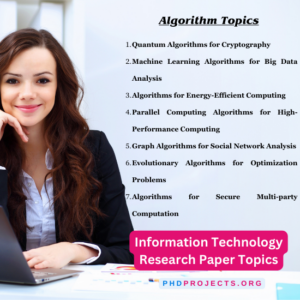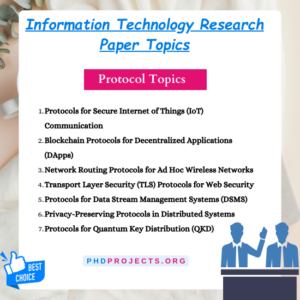Information Technology Research Paper Topics
Looking for intruding IT research paper topics? In the area of Information Technology (IT), the following topics are crucial to enhance network efficiency, data protection and computational strength. Our team are well known for customized writing for various research areas, including information technology and computer science. Contact our help desk team who gives you immediate solution. We examine a list of various effective and advanced IT topics for research paper that are relevant to algorithms and protocols:
Algorithm Topics
- Machine Learning Algorithms for Big Data Analysis
- By aiming at the practical executing abilities, expandability and correctness, explore new machine learning methods that are developed to execute and observe big data effectively.
- Quantum Algorithms for Cryptography
- To divide the ordinary encoding techniques, discover the possibility of both the development of quantum-resistible cryptographic techniques and the advancement of quantum approaches.
- Algorithms for Energy-Efficient Computing
- Along with energy-attentive assigning methods and hardware-particular improvements, study techniques which are created for reducing energy consumption in computing mechanisms.
- Graph Algorithms for Social Network Analysis
- Concentrating on information diffusion, increasing impact and identification of groups, and determining the application of graph approaches in recognizing social networks.
- Evolutionary Algorithms for Optimization Problems
- In showcasing the flexibility and powerfulness of optimization issues and overcoming different types of them, explore the application of evolutionary techniques like genetic methods.
- Algorithms for Secure Multi-party Computation
- By targeting the applications in safe auctions, data sharing and voting, discover the methods which allow parties to execute a method beyond their inputs at the time of maintaining those inputs personal in a connected manner.
- Parallel Computing Algorithms for High-Performance Computing (HPC)
- To overcome complicated engineering and scientific issues in a highly strengthened way, research the creation of methods which utilizes parallel computing frameworks.

Protocol Topics
- Protocols for Data Stream Management Systems (DSMS)
- In dispersed platforms, target the data purifying, aggregation and query processing for handling consistent data flow practically and studying the developed protocols appropriately.
- Protocols for Secure Internet of Things (IoT) Communication
- The difficulties relevant to data security, interoperability and scalability are being tackled and the creation of safe interaction protocols for IoT devices is investigated.
- Protocols for Quantum Key Distribution (QKD)
- For enabling two parties to create a shared random secret key that is known only to them, research the improvement of protocols especially for quantum key distribution (QKD), and to encode and decode the messages, this can be a great choice to implement.
- Blockchain Protocols for Decentralized Applications (DApps)
- Concentrating on smart agreements, scalability solutions and consensus systems, research the fundamental protocols of blockchain technology which allows the advancement of distributed applications.
- Transport Layer Security (TLS) Protocols for Web Security
- Determine the growth of TLS protocols along with their current developments, limitations in deploying TLS 1.3 and their duty in protecting web interactions.
- Network Routing Protocols for Ad Hoc Wireless Networks
- Aims to the trustworthiness, performance and the capacity to adjust for changeable network topologies through exploring routing protocols which are developed for ad hoc wireless networks.
- Privacy-Preserving Protocols in Distributed Systems
- For personal details extraction, safe multiparty computation and anonymous interaction, discover protocols that are created to confirm the confidentiality in dispersed frameworks.

How to write Data Analysis for Information Technology Research?
Generally, the data analysis section acts as a vital role for the preparation of data by conducting the process like gathering, cleaning, analyzing and presenting the data. Below is a direction that we provide you to write a data analysis chapter for an IT research efficiently:
- Prepare the Data
- Data Cleaning: Assure that your data is structured and pure, before the process of analysis. Managing lost values, rectifying mistakes and eliminating duplicates are the tasks that can be included here.
- Data Transformation: Combining data points, classifying consistent variables and standardizing data are the processes involved when transforming your data into an applicable structure for analysis.
- Descriptive Statistics
- To offer an initial interpretation of the data, begin with descriptive statistics. For quantitative data, it is necessary to attach the measures like standard deviation, range, mean, median and mode.
- Outline the subjects or classifications which have evolved from the data particularly for qualitative data.
- Data Visualization
- Enable the readers to understand abnormalities, figures and directions in a simple way by depicting the data visually with the help of graphs, tables and charts. Scatter plots, heat maps, line graphs and bar charts are the general visualizations involved here.
- Assure that every visual contains a description through discussing the aspect that it indicates and is labeled explicitly.
- Statistical Analysis
- Based on your research assumptions and queries, work on related statistical experiments. It can be anything like regression analysis for considering connections among variables, highly difficult observations such as factor analysis or cluster analysis and t-tests and ANOVA for differentiating communities.
- For selecting the importance level that is utilized for decision-making and every statistical experiment, define the reasons in an exact way.
- Interpret the Results
- In terms of your research query, explain the solutions for every analysis which are executed. You can describe the aspects that the results show about your aimed research queries or assumptions.
- Along with other confidence intervals or p-values, and what they are expressing according to your assumptions, you should be transparent about the essentiality of statistical results.
- Discuss the Implications
- Describe the realistic effects of your detections, after the statistical importance. Define the aspects which they recommend for future experience, agreement and exploration. Discuss how the previous sense of insights in IT is supported by these aspects.
- Address Limitations
- By considering the mistakes in the data gathering process, challenges of the implemented statistical techniques and possible errors, accept all difficulties of your data analysis task. Explain clearly in what way the understanding of your findings are impacted by these challenges.
- Ensure Clarity and Precision
- You should confirm that sufficient detail is offered for imitation and also neglect using extremely technical language which is unavailable to a few readers. This chapter must be written in an accurate format clearly.
- To maintain the intended major text, employ appendices for additional resources like complicated mathematical derivations and elaborated tables.
- Review and Revise
- For perfection and precision, check your data analysis phase. To gain reviews, ask the professors and colleagues to examine your work.
- Verify that your insights reflect on the demonstrated data and that the entire diagrams and tables are cited in the text properly.
Example Structure for a Data Analysis Section
- Data Analysis
3.1 Descriptive Statistics
- Quantitative Data Analysis
- Qualitative Data Summary
3.2 Data Visualization
3.3 Statistical Analysis
- T-test for Comparing Group Means
- Regression Analysis for Variables X and Y
3.4 Interpretation of Results
- Implications of Findings
- Limitations and Considerations
Information Technology Algorithm Writing Services
Latest Algorithm are used by phdprojects.org experts for your IT research paper we stay restructured on trending algorithms and constantly update our skills on modern trends. Are you curious about your research work? Want to score a high grade? Get elite Algorithm Writing Services from our skilled developers we explain to you the work briefly. There will be no errors in our work stay in touch with us.
- Analysis of the behavior of customers in the social networks using data mining techniques
- Research on data mining models for the internet of things
- A Crypto-Based Approach to Privacy-Preserving Collaborative Data Mining
- Data Mining in Credit Scoring and Future Application
- A new geospatial data model to facilitate geographic data mining and knowledge discovery
- Comprehensive Data Management System of the Electric Power Enterprise based on the Interdisciplinary Data Mining
- Data Mining Method and Empirical Research for Extension Architecture Design
- Data Mining on the Candela Cloud Platform
- Classification and evaluation of data mining techniques for data stream requirements
- Using data mining methods for improvement of product and process quality
- EasySDM: An integrated and easy to use Spatial Data Mining platform
- The value of data mining for surveillance video in big data era
- An approach for predicting employee churn by using data mining
- Application Research of Clustering Algorithm Based on K-Means in Data Mining
- A Purchasing Sequences Data Mining Method for Customer Segmentation
- Analysis and Application of Consumer Features with Cloud Computing and Data Mining Technology
- Analysis for data preprocessing to prevent direct discrimination in data mining
- Genetic deep neural networks using different activation functions for financial data mining
- Effect of data skewness and workload balance in parallel data mining
- Design and Implementation of Manufacturing Enterprise Innovation Management System Based on Data Mining Technology